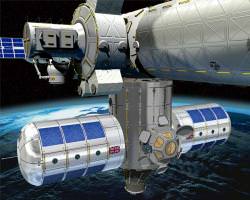British scientists hope to improve living conditions on the International Space Station (ISS) by designing a new addition: the Habitation Extension Module (HEM). Although the plan is currently unofficial, it is hoped the proposal will get accepted and built for a 2011 launch. This would be a massive victory for UK space aspirations, as the nation currently does not have its own space agency and depends on project collaboration with the European Space Agency (ESA) to develop new space technology. The new HEM design features the UK national flag, the Union Jack, perhaps a symbol for the beginning of a British foothold in space.
The proposed habitat design would actually consist of two modules attached to the Node 3 segment of the station. Intended to provide extra accommodation for six crew members (the station currently holds a complement of three astronauts), this design should be welcomed as the ISS is scheduled to accommodate six people in 2009, signifying that the station will move into a “fully operational” phase of its construction.
As the Space Shuttle would have retired by the time HEM is sent to the station, launch will depend on the Russian Soyuz-Fregat rocket, and final approach to the station would use a built-in propulsion system. In addition to the module, three tons of supplies will be on board, stocking the ISS with food and equipment.
The proposed design will be 12.5 feet in diameter and 18.7 in length, adding a total of 3,531.5 cubic feet of living space. This 24% increase in space from the current living volume of 15,000 cubic feet would surely be a welcomed relief to the ISS occupants, making our only space station a more comfortable place to live and work.
The project would come with a pretty heavy price tag. Convincing the UK government to invest approximately £1 billion ($2 billion) in the construction and running of the module till 2015 might, however, stall the British desire for a strong presence in space.
 Source: Space.com

